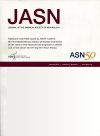SGLT2 Inhibitors Blunt Kidney Magnesium Wasting in Acute Cisplatin-Induced Hypomagnesemia with Effects on the Thick Ascending Limb and Distal Convoluted Tubule
Sodium-glucose cotransporter 2 inhibitors restored magnesium serum levels in cisplatin-treated rats.Empagliflozin reversed cisplatin-induced Na+-K+-Cl− cotransporter 2 inhibition and claudin-16 downregulation in the thick ascending limb.Empagliflozin mitigated distal convoluted tubule area reduction, normalized NaCl cotransporter function, and restored transient receptor potential melastatin 6 expression.
Background
Cisplatin, a chemotherapeutic agent, induces kidney magnesium wasting and hypomagnesemia. Recent studies suggest that sodium-glucose cotransporter 2 inhibitors elevate serum magnesium concentration in patients with or without diabetes. We hypothesized that the sodium-glucose cotransporter 2 inhibitor empagliflozin attenuates acute cisplatin-induced hypomagnesemia by acting on the thick ascending limb (TAL) and distal convoluted tubule (DCT), key sites of magnesium reabsorption.
Methods
Adult male Wistar rats received weekly treatments of cisplatin (2.5 mg/kg) or saline (vehicle) for 5 weeks. After 3 weeks, rats were randomized to receive empagliflozin (10 mg/kg per day) or water (vehicle) for the next 15 days.
Results
Cisplatin-treated rats developed significant hypomagnesemia with increased fractional excretion of magnesium. Empagliflozin treatment reduced fractional excretion of magnesium and restored serum magnesium levels. In the TAL, cisplatin-treated rats had higher Na+-K+-Cl− cotransporter 2 (NKCC2) abundance but lower phosphorylated NKCC2 and claudin-16 levels than empagliflozin-treated cisplatin rats, whose protein levels were similar to controls. By contrast, claudin-19 abundance in the TAL was higher in cisplatin-treated rats than in controls and unaffected by empagliflozin treatment. In the DCT, cisplatin-treated rats displayed reduced abundance of the NaCl cotransporter (NCC), the magnesium channel transient receptor potential melastatin 6, and NCC phosphorylation, all of which were rescued by empagliflozin. Unexpectedly, cisplatin-treated rats exhibited higher mRNA expression and protein abundance of TRPM7 compared with empagliflozin-treated cisplatin rats, whose levels were similar to controls. Diuretic challenge tests with furosemide or hydrochlorothiazide confirmed reduced NKCC2 and NCC activity in cisplatin-treated rats. However, the natriuretic response to furosemide or hydrochlorothiazide did not differ between control and empagliflozin-treated cisplatin rats. Immunohistochemistry suggested that empagliflozin reversed cisplatin-induced DCT remodeling.
Conclusions
Empagliflozin reduces kidney magnesium wasting and restores serum magnesium in cisplatin-treated rats, likely through reversing NKCC2 inhibition and claudin-16 downregulation in the TAL while normalizing NCC function and restoring transient receptor potential melastatin 6 expression in the DCT.




